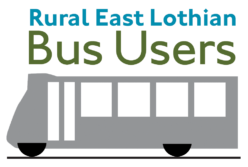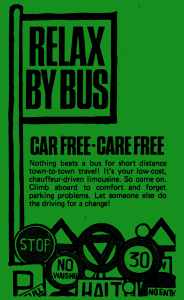Barry Turner is a town planner who has spent much of his professional life promoting at both local and national government level the relationship between transport and land use planning and stressing the importance of that relationship. After retiring he became a local councillor in East Lothian taking on the role of Planning Convener and cabinet member for environment and transport. No longer a councillor, he maintains an involvement with transport through RELBUS and as a member of the South East Scotland Transport partnership (SEStran).
Most of the bus services in this country are run by businesses looking for the most profitable routes. These tend to be in cities and along major corridors. To fill the gaps in the commercial network, local councils are allowed to contract operators to run services for them. These are known as ‘supported services’, and tend to be on rural routes or late-night services which would not be commercially viable. The councils set the terms of the contract in a tender and invite operators to quote the cost of running them. Traditionally the lowest cost tender is accepted.
However, new national guidance stresses the importance of extracting the best possible outcomes from the resources and suggests the establishment of integrated transport units which enable local authorities to create packages of work across sectors to maximise the use of vehicles and staff, ensure full use is made of existing local bus services for education and social work purposes and deliver consistency of standards across modes. They make particular reference to the benefits of integrating the commissioning and delivery of local authority transport with non-emergency healthcare transport.
An underlying theme is that those responsible for procuring road passenger transport need to use situational intelligence grounded in practical experience; hence the title that has been given to this approach by RELBUS: ‘Intelligent Tendering’. It is based on a premise that there is no single best way to procure passenger transport. Strategies need to be based around local circumstances, policy objectives and an understanding of the supplier market, commercial, public sector and voluntary. Local transport units can thus determine how best to encourage these three sectors to develop their own provision and then determine what additional provision needs to be procured and how. It is necessarily an innovative partnership approach, consumer-focussed and employing an extensive toolkit.
RELBUS sees great potential to achieve a wider range of rural transport connections in this approach and there was support for something similar at a conference entitled ‘Community and Supported Transport – is there a better way?’ held in Haddington in March 2012. The current issues here are threefold. Firstly, supported buses, the traditional way of providing for many socially necessary transport needs not met by commercial operations, are limited in their potential to serve the more remote communities. Secondly, although they provide essential links for some, supported buses run for much of the time almost empty and do not represent good value for money. Thirdly, there are significant resources available in both the public and voluntary sectors which have the potential to remedy these deficiencies by an involvement over and above what they already offer.
It is surprising just how much in the way of potentially alternative provision exists. It comprises council buses, taxis, Handicabs, WRVS transport, community buses, NHS transport, car clubs and car sharing. Some are already made use of to varying degrees. Some are in their infancies with much scope for development. Some just need a catalyst to enable them to make a significant contribution. All could have a role to play to supplement or indeed replace in some instances supported bus services so that the widest range of transport needs are met for those without access to private transport wherever they are, and to offer an alternative to the private car for those who wish to reduce their transport-related environmental footprint.
To do things in a novel and exciting way across the sectors will need organisation and coordination. The problem is that the change will have to be delivered by a range of local agencies working more closely together. At present, however, there is a lack of organisation, joined up thinking and coordination. Red tape may also play a part.
So how could we move forward? A first stage would be information gathering, a comprehensive survey of need, particularly unmet needs, coupled with an inventory of all available community transport in the public and voluntary sectors and what it is able to offer. With information gathered an assessment can be made about where and how conventional bus services, both commercial and supported, can most appropriately and cost effectively be used and adapted to meet need. Where there are gaps, and there will be many, the assessment and negotiation moves to what the other organisations and providers can do to fill them by adapting their operations at minimum cost. Mechanisms for co-ordination of provision, including with rail services, and information dissemination would be essential. Finally any remaining gaps would be the subject of tendering within the public and voluntary sectors for the necessary community transport provision. New forms of provision whether funded or unfunded could be branded ‘East Lothian Community Transport’. Arrangements for the use of senior citizen bus passes would need to be put in place.
This approach could represent the ‘better way’ which the March 2012 conference was investigating. The end product could be better service provision for the same financial input by introducing novelty, flexibility and adaptability. Significantly it could incorporate all four of the priorities for improving public transport identified by RELBUS: integration, information, innovation and involvement.



